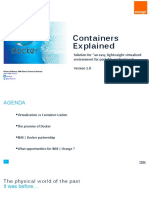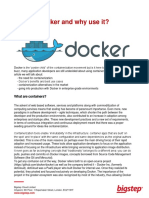0% found this document useful (0 votes)
51 views29 pagesIntro Docker Containers
The document discusses Docker and microservices. It introduces Docker as a way to package applications into standardized units for software development. Microservices break applications into small, independent services that use language-agnostic APIs to communicate. The document suggests Docker and microservices help address issues that arise from developing applications across multiple environments, technologies and hardware by allowing components to be built and run independently.
Uploaded by
Aiemen AltafCopyright
© © All Rights Reserved
We take content rights seriously. If you suspect this is your content, claim it here.
Available Formats
Download as PDF, TXT or read online on Scribd
0% found this document useful (0 votes)
51 views29 pagesIntro Docker Containers
The document discusses Docker and microservices. It introduces Docker as a way to package applications into standardized units for software development. Microservices break applications into small, independent services that use language-agnostic APIs to communicate. The document suggests Docker and microservices help address issues that arise from developing applications across multiple environments, technologies and hardware by allowing components to be built and run independently.
Uploaded by
Aiemen AltafCopyright
© © All Rights Reserved
We take content rights seriously. If you suspect this is your content, claim it here.
Available Formats
Download as PDF, TXT or read online on Scribd
/ 29






















































